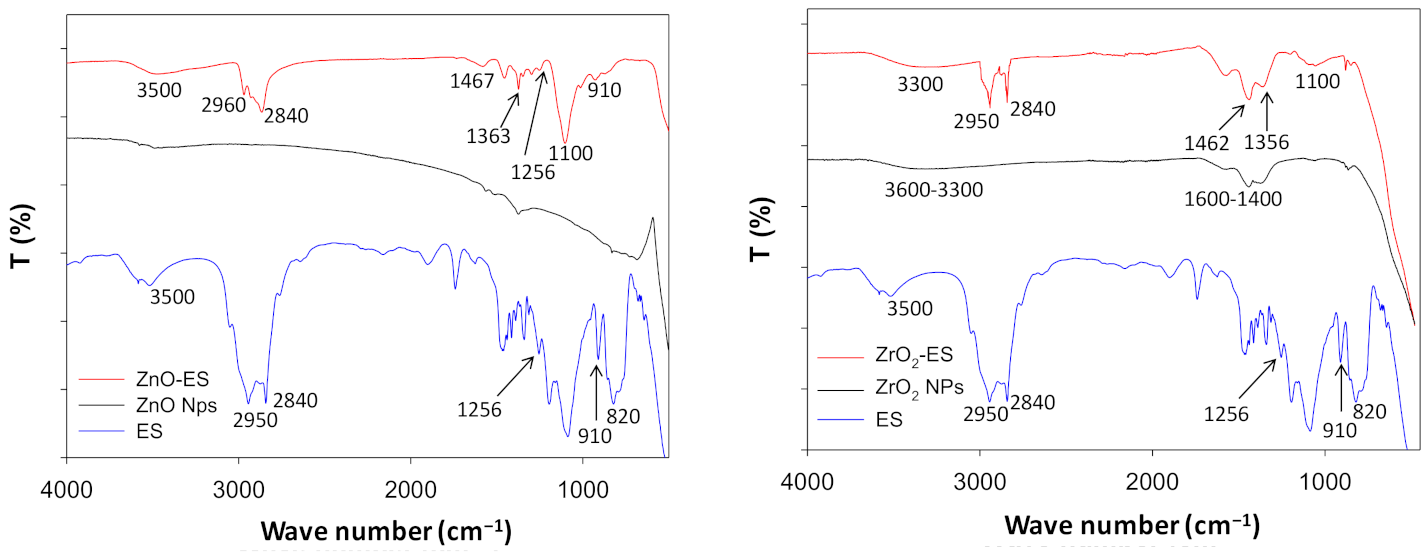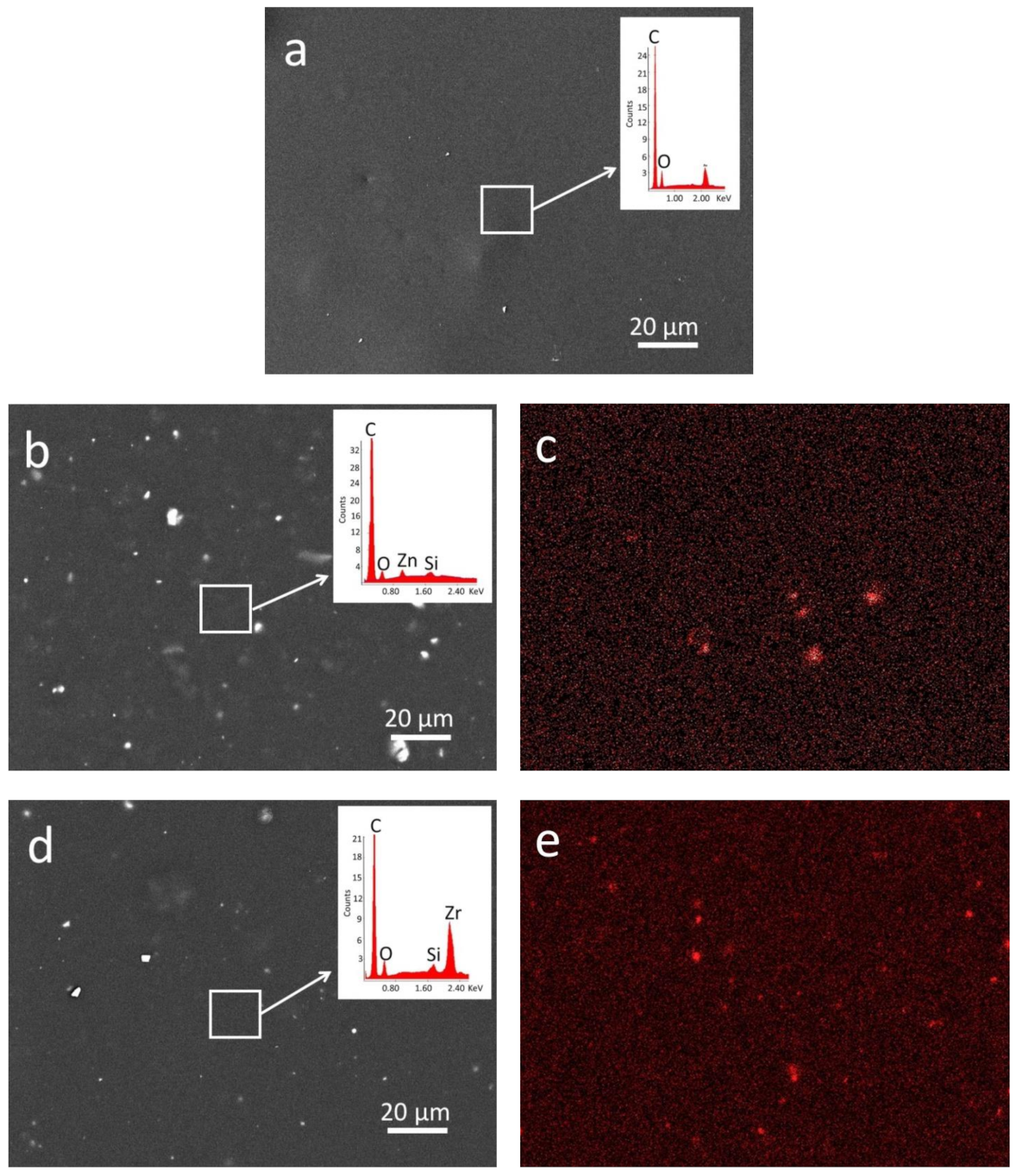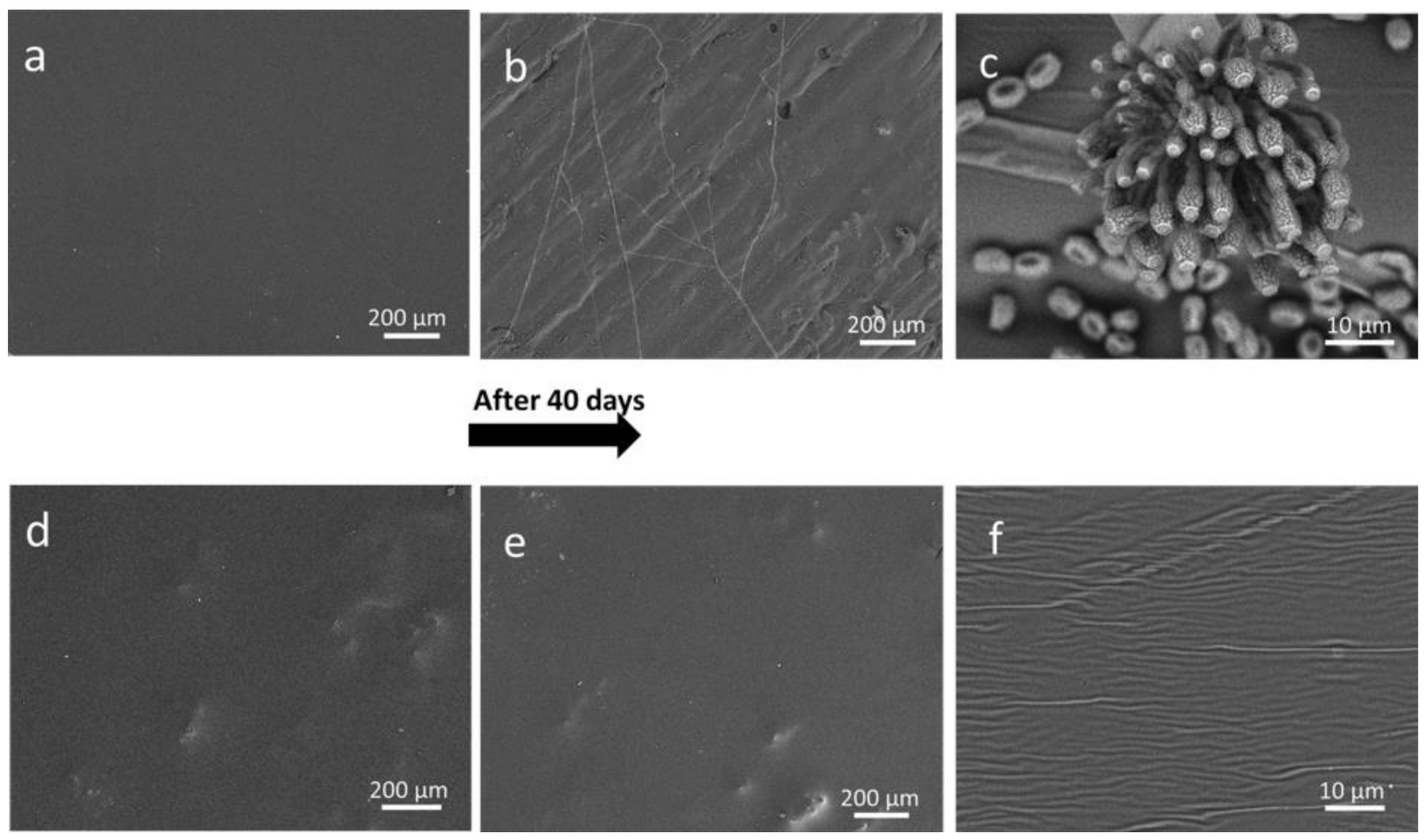Improving the Protective Properties of Shellac-Based Varnishes by Functionalized Nanoparticles
Abstract
:1. Introduction
2. Materials and Methods
2.1. Materials
2.2. Synthesis and Characterization of Functionalized Nanoparticles
2.3. Synthesis of Varnishes
2.4. Preparation of Coated Wood Samples and Coating Films
2.5. Instrumental Techniques and Testing Methods
3. Results and Discussion
3.1. Characterization of Nanoparticles (NPs) and Functionalized NPs
3.2. Characterization of Coatings
3.2.1. Coating Films
3.2.2. Treated Wood Specimens
3.3. Performances of Coatings
4. Conclusions
Supplementary Materials
Author Contributions
Funding
Institutional Review Board Statement
Informed Consent Statement
Data Availability Statement
Acknowledgments
Conflicts of Interest
References
- Bose, P.K.; Sankaranarayanan, Y.; Sengupta, S.C. Chemistry of Lac; Indian Lac Research Institute: Ranchi, India, 1963. [Google Scholar]
- Limmatvapirat, S.; Panchapornpon, D.; Limmatvapirat, C.; Nunthanid, J.; Luangtana-Anan, M.; Puttipipatkhachorn, S. Formation of shellac succinate having improved enteric film properties through dry media reaction. Eur.J. Pharm. Biopharm. 2008, 70, 335–344. [Google Scholar] [CrossRef]
- Weththimuni, M.L.; Capsoni, D.; Malagodi, M.; Milanese, C.; Licchelli, M. Shellac/nanoparticles dispersions as protective materials for wood. Appl. Phys. A 2016, 122, 1058–1069. [Google Scholar] [CrossRef]
- Wang, J.; Chen, L.; He, Y. Preparation of environmental friendly coatings based on natural shellac modified by diamine and its applications for copper protection. Prog. Org. Coat. 2008, 62, 307–312. [Google Scholar] [CrossRef]
- Licchelli, M.; Malagodi, M.; Somaini, M.; Weththimuni, M.; Zanchi, C. Surface treatments of wood by chemically modified shellac. Surf. Eng. 2013, 29, 121–127. [Google Scholar] [CrossRef]
- Šimunková, K.; Pánek, M.; Zeidler, A. Comparison of selected properties of shellac varnish for restoration and polyurethane varnish for reconstruction of historical artefacts. Coatings 2018, 8, 119. [Google Scholar] [CrossRef] [Green Version]
- Cook, W. The Complete Guide to Repairing & Restoring Furniture; Southwater: Leicester, UK, 2015; p. 256. ISBN1 10 1780191448. ISBN2 13 978-1780191447. [Google Scholar]
- Nevin, A.; Echard, J.P.; Thoury, M.; Comelli, D.; Valentini, G.; Cubeddu, R. Excitation emission and time-resolved fluorescence spectroscopy of selected varnishes used in historical musical instruments. Talanta 2009, 80, 286–293. [Google Scholar] [CrossRef] [PubMed]
- Limmatvapirat, S.; Nuntanid, J.; Luangtana-Anan, M.; Puttipipatkhachorn, S. Effect of alkali treatment on properties of native shellac and stability of hydrolyzed shellac. Pharm. Dev. Technol. 2005, 1, 41–46. [Google Scholar] [CrossRef] [PubMed]
- Otto, J.T.; Trumbo, D.L. A shellac derivative in thermoset coatings. J. Coat. Technol. Res. 2010, 7, 525–527. [Google Scholar] [CrossRef]
- David, M.E.; Ion, R.M.; Grigorescu, R.M.; Iancu, L.; Andrei, E.R. Nanomaterials used in conservation and restoration of cultural heritage: An up-to-date overview. Materials 2020, 13, 2064. [Google Scholar] [CrossRef] [PubMed]
- Fierascu, R.C.; Doni, M.; Fierascu, I. Selected aspects regarding the restoration/conservation of trational wood and masonry building materials: A short overview of the last decade findings. Appl. Sci. 2020, 10, 1164. [Google Scholar] [CrossRef] [Green Version]
- Licchelli, M.; Marzolla, S.J.; Poggi, A.; Zanchi, C. Crosslinked fluorinated polyurethanes for the protection of stone surfaces from graffiti. J. Cult. Herit. 2011, 12, 34–43. [Google Scholar] [CrossRef]
- Licchelli, M.; Malagodi, M.; Weththimuni, M.; Zanchi, C. Nanoparticles for conservation of bio-calcarenite stone. Appl. Phys. A 2014, 114, 673–683. [Google Scholar] [CrossRef]
- Hong, R.Y.; Li, J.H.; Chen, L.L.; Liu, D.Q.; Li, H.Z.; Zheng, Y.; Ding, J. Synthesis, surface modification and photocatalytic property of ZnO nanoparticles. Powder Technol. 2009, 189, 426–432. [Google Scholar] [CrossRef]
- Luo, K.; Zhou, S.; Wu, L.; Gu, G. Dispersion and functionalization of nonaqueous synthesized zirconia nanocrystals via attachment of silane coupling agents. Langmuir 2008, 24, 11497–11505. [Google Scholar] [CrossRef] [PubMed]
- Hong, R.; Pan, T.; Qian, J.; Li, H. Synthesis and surface modification of ZnO nanoparticles. Chem. Eng. J. 2006, 119, 71–81. [Google Scholar] [CrossRef]
- Wu, Y.L.; Tok, A.I.Y.; Boey, F.Y.C.; Zeng, X.T.; Zhang, X.H. Surface modification of ZnO nanocrystals. App. Surf. Sci. 2007, 253, 5473–5479. [Google Scholar] [CrossRef]
- Faure, B.; Salazar-Alvarez, G.; Ahniyaz, A.; Villaluenga, I.; Berriozabal, G.; De Miguel, Y.R.; Bergström, L. Dispersion and surface functionalization of oxide nanoparticles for transparent photocatalytic and UV-protecting coatings and sunscreens. Sci. Technol. Adv. Mater. 2013, 14, 23001. [Google Scholar] [CrossRef] [PubMed]
- Singh, A.K.; Nakate, U.T. Microwave Synthesis, Characterization, and Photoluminescence Properties of Nanocrystalline Zirconia. Sci. World. J. 2014, 2014, 349457. [Google Scholar] [CrossRef] [Green Version]
- Zhang, Q.; Shen, J.; Wang, J.; Wu, G.; Chen, L. Sol-gel derived ZrO2-SiO2 highly reflective coatings. Int. J. Inorg. Mater. 2000, 2, 319–323. [Google Scholar] [CrossRef]
- Wright, P.K.; Evans, A.G. Mechanisms governing the performance of thermal barrier coating. Curr. Opin. Solid. State. Mater. Sci. 1999, 4, 25–30. [Google Scholar] [CrossRef]
- Piconi, C.; Maccauro, G. Zirconia as a ceramic biomaterial. Biomaterials 1999, 20, 1–25. [Google Scholar] [CrossRef]
- Sajjad, M.; Feichtenschlager, B.; Pabisch, S.; Svehla, J.; Koch, T.; Seidler, S.; Peterlik, H.; Kickelbick, G. Study of the effect of the concentration, size and surface chemistry of zirconia and silica nanoparticle fillers within an epoxy resin on the bulk properties of the resulting nanocomposites. Polym. Int. 2012, 61, 274–285. [Google Scholar] [CrossRef]
- Hong, R.Y.; Qian, J.Z.; Cao, J.X. Synthesis and characterization of PMMA grafted ZnO nanoparticles. Powder Technol. 2006, 163, 160–168. [Google Scholar] [CrossRef]
- Zhang, Q.; Huang, R.; Guo, L.-H. One-step and high-density protein immobilization on epoxysilane-modified silica nanoparticles. Chin. Sci. Bull. 2009, 54, 2620–2626. [Google Scholar] [CrossRef] [Green Version]
- Zhao, J.; Milanova, M.; Warmoeskerken, M.M.C.G.; Dutschk, V. Surface modification of TiO2 nanoparticles with silane coupling agents. Colloid. Surf. A Physicochem. Eng. Asp. 2012, 413, 273–279. [Google Scholar] [CrossRef]
- Lee, H.S.; Park, J.M.; Hwang, K.H.; Lim, H.M. Surface Functionalization of Zirconia Nanocrystals with Silane Coupling Agent and its Dispersion Behavior in O-Phenylphenoxyethyl Acrylate. Mat. Sci. Forum. 2018, 922, 20–25. [Google Scholar] [CrossRef]
- Lu, H.T. Synthesis and characterization of amino-functionaliazed silica nanoparticles. Colloid. J. 2013, 75, 311–318. [Google Scholar] [CrossRef]
- Iijima, M.; Sato, N.; Lenggoro, I.W.; Kamiya, H. Surface modification of BaTiO3 particles by silane coupling agents in different solvents and their effect on dielectric properties of BaTiO3/epoxy composites. Colloid. Surf. A Physicochem. Eng. Asp. 2009, 352, 88–93. [Google Scholar] [CrossRef]
- Ha, T.T.; Canh, T.D.; Tuyen, N.V. A Quick Process for Synthesis of ZnO Nanoparticles with the Aid of Microwave Irradiation. ISRN Nanotech. 2013, 2013, 497873. [Google Scholar] [CrossRef] [Green Version]
- Athauda, T.J.; Williams, W.; Roberts, K.P.; Ozer, R.R. On the surface roughness and hydrophobicity of dual-size double-layer silica nanoparticles. J. Mater. Sci. 2013, 48, 6115–6120. [Google Scholar] [CrossRef]
- Turco, A. Coloritura Verniciatura e Laccatura Del Legno, 3rd ed.; Hoepli: Milan, Italy, 2005. [Google Scholar]
- Weththimuni, M.L.; Canevari, C.; Legnani, A.; Licchelli, M.; Malagodi, M.; Ricca, M.; Zeffiro, A. Experimental characterization of oil-colophony varnishes: A preliminary study. J. Int. Conserv. Sci. 2016, 7, 813–826. [Google Scholar]
- UNI EN 15886: 2010, Conservazione dei Beni Culturali-Metodi di Prova-Misura del Aolore Delle Superfici; UNI Ente Italiano di Unificazione: Milan, Italy, 2010.
- UNI EN 15802:2010, Conservazione dei Beni culturali-Metodi di Prova-Determinazione dell’Angolo di Contatto Statico; UNI Ente Italiano di Unificazione: Milan, Italy, 2010.
- Weththimuni, M.L.; Capsoni, D.; Malagodi, M.; Licchelli, M. Improving Wood Resistance to Decay by Nanostructured ZnO-Based Treatments. J. Nanomater. 2019, 2019, 6715756. [Google Scholar] [CrossRef]
- Scalarone, D.; Lazzari, M.; Chiantore, O. Ageing behaviour and pyrolytic characterization of diterpenic resins used as art materials: Colophony and venice turpentine. J. Anal. Appl. Pyrolysis 2002, 64, 345–361. [Google Scholar] [CrossRef]
- Yu, Y.; Jiang, Z.; Wang, G.; Tian, G.; Wang, H.; Song, Y. Surface functionalization of bamboo with nanostructured ZnO. Wood Sci. Technol. 2012, 46, 781–790. [Google Scholar] [CrossRef]
- ISO 15184:2012, Paints and Varnishes—Determination of Film Hardness by Pencil Test, 2nd ed.; International Organization for Standardization: Genève, Switzerland, 2012.
- Grasset, F.; Saito, N.; Li, D.; Park, D.; Sakaguchi, I.; Ohashi, N.; Haneda, H.; Roisnel, T.; Mornet, S.; Duguet, E. Surface modification of zinc oxide nanoparticles by aminopropyltriethoxysilane. J. Alloys Compd. 2003, 360, 298–311. [Google Scholar] [CrossRef]
- Sowa, H.; Ahsbahs, H. High-pressure X-ray investigation of zincite ZnO single crystals using diamond anvils with an improved shape. J. Appl. Cryst. 2006, 39, 169–175. [Google Scholar] [CrossRef]
- Mueen, R.; Lerch, M.; Cheng, Z.; Konstantinov, K. Na-doped ZnO UV filters with reduced photocatalytic activity for sunscreen applications. J. Mater. Sci. 2020, 55, 2772–2786. [Google Scholar] [CrossRef]
- Dippel, A.C.; Jensen, K.M.Ø.; Tyrsted, C.; Bremholm, M.; Bøjesen, E.D.; Saha, D.; Birgisson, S.; Christensen, M.; Billingec, S.J.L.; Iversena, B.B. Towards atomistic understanding of polymorphism in the solvothermal synthesis of ZrO2 nanoparticles. Acta Cryst. 2016, A72, 645–650. [Google Scholar]
- Hernawan; Septawendar, R.; Sofiyaningsih, N.; Sutardi, S. The zirconia phase transformation in the preparation of nano zirconia by calcining a gel-emulsion precursor. J. Ceram. Process. Res. 2011, 12, 561–566. [Google Scholar]
- Anandan, K.; Rajendran, V. A Low-temperature synthesis and characterization of tetragonal-ZrO2 nbanoparticles via simple hydrothermal process. J. Phys. Sci. 2013, 17, 179–184. [Google Scholar]
- Manjunatha, S.; Dharmaprakash, M.S. Synthesis and characterization of cerium doped ZrO2 blue-green emitting nanophosphors. Mater. Lett. 2016, 164, 476–479. [Google Scholar] [CrossRef]
- Guo, Z.; Wei, S.; Shedd, B.; Scaffaro, R.; Ereira, T.; Hahn, H. Particles surface engineering effect on the mechanical, optical and photoluminescent properties of ZnO/vinyl-ester resin nanocomposites. J. Mater. Chem. 2007, 17, 806–813. [Google Scholar] [CrossRef]
- Nagaraju, G.; Udayabhanu, G.; Shivaraj, P.; Prashanth, S.A.; Shastri, M.; Yathish, K.V.; Anupama, C.; Rangappa, D. Electrochemical heavy metal detection, photocatalytic, photoluminescence, biodiesel production and antibacterial activities of Ag-ZnO nanomaterial. Mater. Res. Bull. 2017, 94, 54–63. [Google Scholar] [CrossRef]
- Ma, J.; Duan, L.; Lu, J.; Lyu, B.; Gao, D.; Wu, X. Fabrication of modified hydrogenated castor oil/GPTMSZnO composites and effect on UV resistance of leather. Sci. Rep. 2017, 7, 3742. [Google Scholar]
- Schramm, C. High temperature ATR-FTIR characterization of the interaction of polycarboxylic acids and organotrialkoxysilanes with cellulosic material. Spectroch. Acta A Mol. Biomol. Spectrosc. 2020, 243, 118815. [Google Scholar] [CrossRef] [PubMed]
- Fedtke, M.; Domaratiu, F. Curing of epoxide resins by anhydrides of dicarboxylic acids: Model reactions. Polym. Bull. 1986, 15, 13–19. [Google Scholar] [CrossRef]
- Tang, J. Specific and irreversible iInactivation of pepsin by substrate-like epoxides. J. Biol. Chem. 1971, 246, 4510–4517. [Google Scholar] [CrossRef]
- Ross W., C.J. The reactions of certain epoxides in aqueous solutions. J. Chem. Soc. 1950, 2257–2272. [Google Scholar] [CrossRef]
- Goswami, D.N.; Kumar, S. Study on the curing of shellac with epoxy resins by dielectric measurements. Angew. Makromol. Chem. 1984, 126, 145–152. [Google Scholar] [CrossRef]
- Fahim Ansari, M.; Sarkhel, G.; Nath Goswami, D.; Baboo, B. Coating properties of shellac modified with synthesised epoxidised-novolac resin. Pigm. Resin Technol. 2014, 43, 314–322. [Google Scholar] [CrossRef]
- Clemens, R.J.; Rector, F.D. Synthesis of acetoacetyl—functional resins. J. Coat. Technol. 1989, 61, 83–91. [Google Scholar]
- Lausecker, R.; Badilita, V.; Gleißner, U.; Wallrabe, U. Introducing natural thermoplastic shellac to microfluidics: A green fabrication method for point-of-care devices. Biomicrofluidics 2016, 10, 044101. [Google Scholar] [CrossRef] [Green Version]
- Fahim Ansari, M.; Sarkhel, G.; Nath Goswami, D.; Baboo, B. Changes in the properties of shellac on blending with rosin, effect on storage. Pigm. Resin Technol. 2013, 42, 256–263. [Google Scholar] [CrossRef]
- Thompson, A.C.; Vaughan, D. X-ray Data Booklet, 2nd ed.; University of California: Berkeley, CA, USA, 2001. [Google Scholar]
- Younan, H.; Binghai, L.; Zhiqiang, M.; Teong, J. Studies and applications of standardless EDX quantification method in failure analysis of wafer fabrication. In Proceedings of the 15th International Symposium on the Physical and Failure Analysis of Integrated Circuits, Singapore, 7–11 July 2008. [Google Scholar]
- Cristea, M.V.; Riedl, B.; Blanchet, P. Effect of addition of nanosized UV absorbers on the physico-mechanical and thermal properties of an exterior waterborne stain for wood. Prog. Org. Coat. 2011, 72, 755–762. [Google Scholar] [CrossRef]
- Coelho, C.; Nanabala, R.; Meénager, M.; Commereuc, S.; Verney, V. Molecular changes during natural biopolymer ageing- The case of shellac. Polym. Degrad. Stab. 2012, 97, 936–940. [Google Scholar] [CrossRef]
- Auclair, N.; Riedl, B.; Blanchard, V.; Blanchet, P. Improvement of photoprotection of wood coatings by using inorganic nanoparticles as ultraviolet absorbers. For. Prod. J. 2011, 61, 20–27. [Google Scholar] [CrossRef]
- Wang, X.; Yang, F.; Yang, W.; Yang, X. A study on the antibacterial activity of one-dimensional ZnO nanowire arrays: Effects of the orientation and plane surface. Chem. Commun. 2007, 42, 4419–4421. [Google Scholar] [CrossRef] [PubMed]
- Sharma, D.; Rajput, J.; Kaith, B.S.; Kaur, M.; Sharma, S. Synthesis of ZnO nanoparticles and study of their antibacterial and antifungal properties. Thin Solid Films 2010, 519, 1224–1229. [Google Scholar] [CrossRef]
- Patra, P.; Mitra, S.; Debnath, N.; Goswami, A. Biochemical, biophysical, and microarray-based antifungal evaluation of the buffer-mediated synthesized nano zinc oxide: An in vivo and in vitro toxicity study. Langmuir 2012, 28, 16966–16978. [Google Scholar] [CrossRef] [PubMed]
- Mohammed, D.Y. Detection the antifungal effect of zirconium oxide nanoparticles on mold which isolated from momestic’s. AI-Mustansiriyah J. Sci. 2018, 29, 15–22. [Google Scholar]
- Gowri, S.; Gandhi, R.R.; Sundrarajan, M. Structural, optical, antibacterial and antifungal properties of zirconia nanoparticles by biobased protocol. J. Mater. Sci. Technol. 2014, 30, 782–790. [Google Scholar] [CrossRef]







| Films | Tg/°C | Insoluble Fraction in EtOH (%) |
|---|---|---|
| SH | 112 (±1) | 17 (±6) |
| ZnO-ES-SH | 108 (±1) | 73 (±10) |
| ZrO2-ES-SH | 105 (±1) | 72 (±6) |
| Varnishes | After Treatments | After UV Ageing | ||
|---|---|---|---|---|
| ΔE* (a) | α (°) | ΔE* (b) | α (°) | |
| SH | 20.9 (±1.2) | 73 (±4) | 17.3 (±0.3) | 65 (±2) |
| ZnO-ES-SH | 16.7 (±0.1) | 91 (±7) | 8.6 (±0.6) | 87 (±3) |
| ZrO2-ES-SH | 22.1 (±0.3) | 104 (±5) | 13.8 (±0.3) | 95 (±2) |
| Varnishes | Films | Wood Specimens |
|---|---|---|
| SH | F | F |
| ZnO-ES-SH | H | H |
| ZrO2-ES-SH | 3H | 3H |
Publisher’s Note: MDPI stays neutral with regard to jurisdictional claims in published maps and institutional affiliations. |
© 2021 by the authors. Licensee MDPI, Basel, Switzerland. This article is an open access article distributed under the terms and conditions of the Creative Commons Attribution (CC BY) license (https://creativecommons.org/licenses/by/4.0/).
Share and Cite
Weththimuni, M.L.; Milanese, C.; Licchelli, M.; Malagodi, M. Improving the Protective Properties of Shellac-Based Varnishes by Functionalized Nanoparticles. Coatings 2021, 11, 419. https://doi.org/10.3390/coatings11040419
Weththimuni ML, Milanese C, Licchelli M, Malagodi M. Improving the Protective Properties of Shellac-Based Varnishes by Functionalized Nanoparticles. Coatings. 2021; 11(4):419. https://doi.org/10.3390/coatings11040419
Chicago/Turabian StyleWeththimuni, Maduka L., Chiara Milanese, Maurizio Licchelli, and Marco Malagodi. 2021. "Improving the Protective Properties of Shellac-Based Varnishes by Functionalized Nanoparticles" Coatings 11, no. 4: 419. https://doi.org/10.3390/coatings11040419
APA StyleWeththimuni, M. L., Milanese, C., Licchelli, M., & Malagodi, M. (2021). Improving the Protective Properties of Shellac-Based Varnishes by Functionalized Nanoparticles. Coatings, 11(4), 419. https://doi.org/10.3390/coatings11040419









